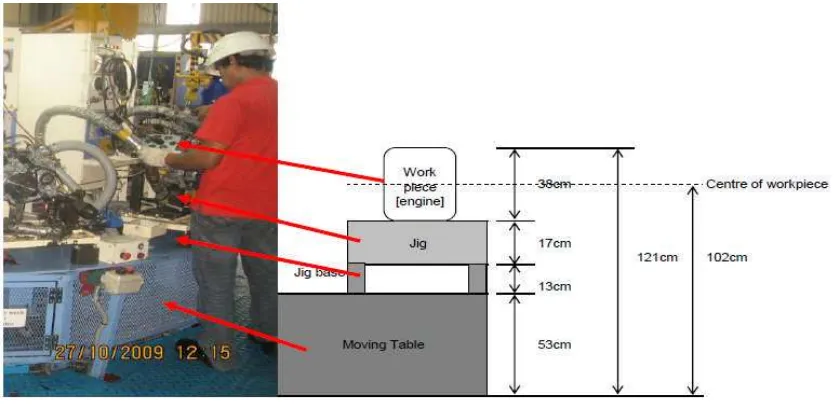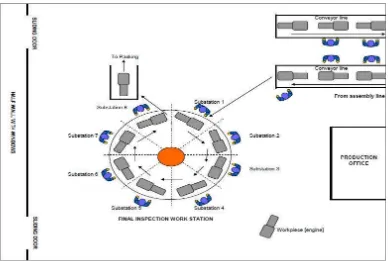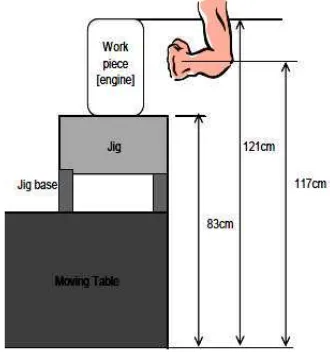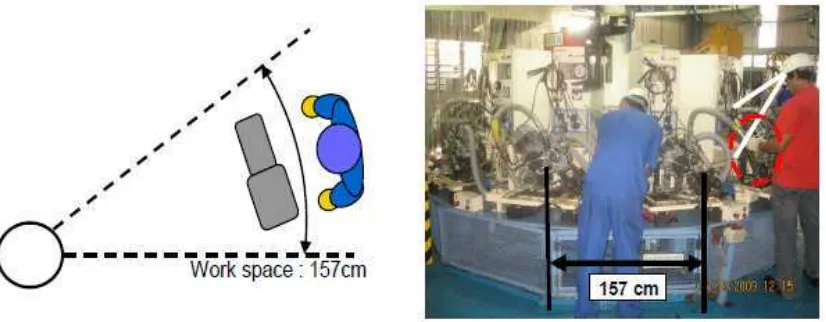National Conference in Mechanical Engineering Research and Postgraduate Studies (2ndNCMER 2010) 3-4 December 2010, Faculty of Mechanical Engineering, UMP Pekan, Kuantan, Pahang, Malaysia; pp. 195-201 ISBN: 978-967-0120-04-1; Editors: M.M. Rahman, M.Y. Taib, A.R. Ismail, A.R. Yusoff, and M.A.M. Romlay ©Universiti Malaysia Pahang
ERGONOMICS ASSESSMENT OF WORKSTATION DESIGN IN AUTOMOTIVE INDUSTRY
1
A.R. Ismail, 2N. Jusoh,2A.Z. Ismail,2M.H. Abu Bakar2, W.H. W. Deraman2and
3
A.P. Puvanasvaran
1
Faculty of Mechanical Engineering, Universiti Malaysia Pahang 22600 Pekan, Pahang,
Phone: +609-4242268, Fax: +609-4242202 Email: arasdan@gmail.com, rasdan@ump.edu.my
2
Department of Mechanical and Material Engineering
Faculty of Engineering and Build Enviroment, Universiti Kebangsaan Malaysia 43600 UKM Bangi, Selangor, Malaysia
3
Faculty of Manufacturing Engineering
Universiti Teknikal Malaysia Melaka (UTeM), Ayer Keroh, 75450 Melaka, Malaysia E-mail: punesh@utem.edu.my
ABSTRACT
The purpose of this study is to demonstrate the ability to interpret the various aspects of ergonomics contributions and influences in the manufacturing industry. The application of knowledge and understanding of the ergonomics theories and techniques in the manufacturing industry also will be demonstrated in this study. Besides that, this report will be able us to appreciate the ergonomic role in manufacturing industry and everyday context by showing the ergonomics contribution towards employees’ health and safety in the workplace and tangible or intangible profitability of the company. Adequate posture, work height, normal and maximum working areas are determined for the intended user population. The procedure for determining the workstation dimensions and layout has been explained. The importance of building a mock-up of the designed workstation and its evaluation with representative subjects is emphasized. A case problem (Final Inspection workstation) is discussed to illustrate the workstation design procedure.
Keywords:Workstation design, Healthy and Safety, Manufacturing Industry ,
INTRODUCTION
efficiency. Many painful afflictions, of musculoskeletal system, known as cumulative trauma disorders (CTD), are associated with the working posture. These are caused and aggravated sometimes by the repeated forceful exertions connected with awkward work postures of the upper extremities (Armstrong et al., 1986).
Often in industry the workstation is designed in an arbitrary manner, giving little consideration to the anthropometric measurements of the anticipated user. The situation is aggravated by the non-availability of usable design parameters or dimensions (Das and Grady, 1983; Das, 1987). The physical dimensions in the design of an industrial workstation are of major importance from the viewpoint of production efficiency, and operator physical and mental well-being. Small changes in workstation dimension can have a considerable impact on worker productivity, and occupational health and safety. Inadequate posture from an improperly designed workstation causes static muscle efforts, eventually resulting in acute localized muscle fatigue, and consequently in decreased performance and productivity, and in enhanced possibility of operator related health hazards (Corlett et al, 1982). The study was conducted on Oktober 2009 at Hicom Yamaha Manufacturing Malaysia (HYMM) Sdn. Bhd. located in Shah Alam, Selangor. HYMM is the only engine manufacturer for Yamaha motorcycle in Malaysia. One of the engine assembly processes, final engine inspection process workstation has been selected for a purpose of study. The study proceeding is related to environmental aspects. The purpose of study is to evaluate any environmental effects that may influence the worker performance at the workstation. The second category is study of existing characteristics workstation.
METHODOLOGY
Study was conducted at engine final inspection workstation which part of engine manufacturing processes as illustrate in Figure 1.
Figure 1: General engine manufacturing flow
working posture and environment. The work and motivation schedule can see in Table 1. This schedule can make workers relax for a while.
Figure 2: Workstation design dimension Table 1: Work and motivation schedule
The layout or experiment set up of Final Inspection Workstation can illustrate by Figure 3. The explanation every substation of Figure 3 points out can be see clearly in Table 2.
Figure 3: Experiments set up
RESULTS AND DISCUSSION
Workstation Design Assessment
Based on the Figure 5, work piece (engine) position is between 83 cm and 121 cm and all working activities for all substations around elbow high. Based on anthropometric data, average elbow height at 95 percentile is 110 cm within range of work piece position. The centre of work piece position is at 102 cm. the result shown that workstation design is suitable for the Malaysian worker. The lowest position of work piece at 83 cm within 95 percentile of fingertip height anthropometric data 69.5 cm. By comparing data from Table 3 below and anthropometric data used in 4.1, stature for all subjects are within 90 percentile of Malaysian people stature (147cm to 177cm). Therefore all the workstations are suitable to be operated by Malaysian people and able to minimize Cumulative Trauma Disorders (CTDs)
Figure 5: Work piece position Table 3: Anthropometric data analysis
Physiology Assessment As Well As Cognitive Of Workers
properly for inspection. The other human body parts which are important in this work station such as eyes for viewing the condition of equipment fixing and to make a conclusion of their own tasks based on standard given. Based on the daily work schedule, workers will not continuously expose to more than four hours performing task since enough rest time has been provided in the middle morning session, afternoon and during evening session. The other task which highly related to human body parts at this work station is engine noise level judgment using normal hearing process. The task which set at substation 5 conducted in a special room (sound proof). Noise level from the engine sound is at 95db. By the result, workers have been assigned to perform task alternately for maximum every four hours. Workers at the others substations are compulsory to wear ear plug.
Continuous training to all workers on environmental, safety and health.
Health check to all workers at least once a year.
Conduct periodical 5S and Safety audit to ensure all working area are in good condition at all situation and to identify any improvement required.
Space of working areas for a subject decided based on recommendation by R&D Division at Head Quarters, Japan.
Employee Suggestion Scheme where employees are encouraged to give a suggestion to management for any improvement from quality, cost, delivery, safety and morale point of view. The practical suggestion will be implemented by management and reward will be given.
REFERENCES
Armstrong, T. J., Radwin, R. G., Hansen, D. J. and Kennedy, K. W. 1986. Repetitive trauma disorders: Job evaluation and design’ Human Factors 28: 325-336
Corlett, E. N. 1988. The investigation and evaluation of work and workplaces Ergonomics 31: 727-734
Corlett, E. N. and Clark, T. S. 1995. The Ergonomics of Workspaces and Machines: A Design Manual, 2nd edn, Taylor & Francis, London, England
Corlett, E. N., Bowssenna, M. and Pheasant, S. T. 1982. Is discomfort related to the postural loading of the joints? Ergonomics 25: 315-322
Das, B. 1987. An ergonomics approach to the design of a manufacturing work system’ Int J Industrial Ergonomics 1: 231-240
Das, B. and Grady, R. M. 1983. Industrial workplace layout design: An application of engineering anthropometry. Ergonomics 26: 433-447
Eastman Kodak Company. 1983. Ergonomics Design for People at Work, Belmont, California, USA, Lifetime Learning
Khalil, T. M. 1972. Design tools and machines to fit the man Industrial Engineering, Institute of Industrial Engineers 4: 32-35
Konz, S. 1967. Design of workstations’ J Industrial Engineering 18: 413-423




